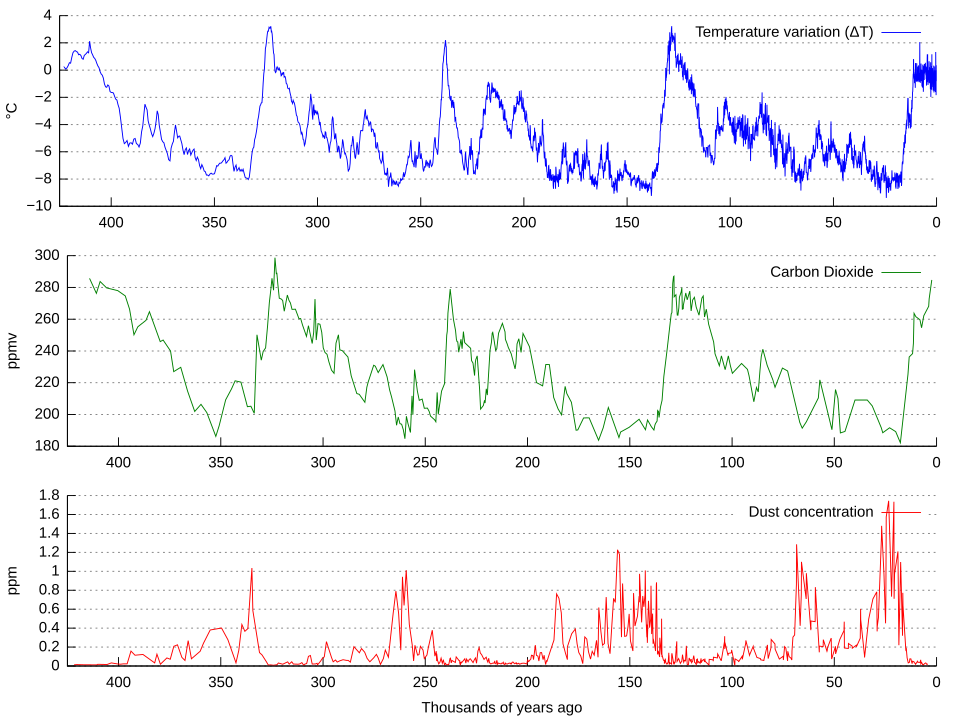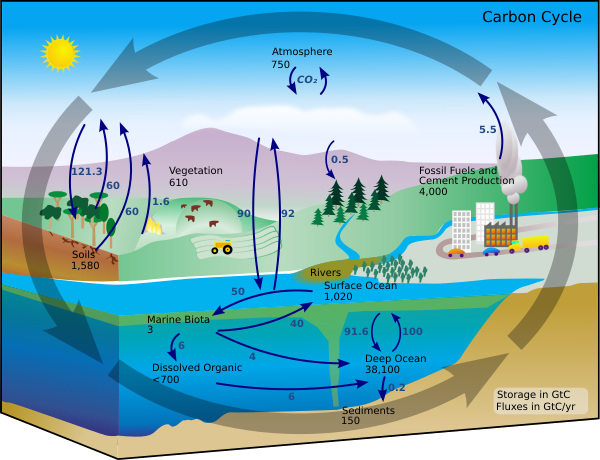AQA Specification focus:
‘Changes in the carbon cycle: natural variation (wildfires, volcanic activity), human impact (hydrocarbon extraction and burning, farming, deforestation, land use changes).’
The carbon cycle has changed over time due to both natural events and human activity, with long-term implications for ecosystems, climate stability, and the Earth's atmospheric balance.
Natural Variation in the Carbon Cycle
Wildfires
Wildfires are uncontrolled fires that consume vast areas of vegetation and forest. These events play a crucial role in altering carbon stores.
Carbon is released rapidly into the atmosphere through combustion of organic matter.
Vegetation loss reduces carbon sequestration by photosynthesis.
Regrowth after fires can later act as a carbon sink, but this process can take decades.
Combustion: The process by which organic material burns in the presence of oxygen, releasing carbon dioxide (CO₂) into the atmosphere.
Volcanic Activity
Volcanoes contribute to natural CO₂ emissions over geological timescales.
Eruptions release carbon dioxide from deep in the Earth's mantle.
Volcanic gases enter the atmosphere, although the contribution is relatively minor compared to anthropogenic sources.
The released CO₂ becomes part of the atmospheric store and contributes to global temperature changes over long periods.
Despite their dramatic nature, volcanoes add only a small percentage of global carbon emissions annually.
Human Impacts on the Carbon Cycle
Human activity since the industrial revolution has significantly disrupted the carbon budget, increasing atmospheric CO₂ concentrations and altering natural balances.
Hydrocarbon Extraction and Burning
Fossil fuels such as coal, oil, and natural gas are carbon-rich substances formed over millions of years.
Extraction brings long-term carbon stores from the lithosphere into active circulation.
Combustion of these fuels for energy is a major driver of anthropogenic climate change.
Carbon Sequestration: The process of capturing and storing atmospheric carbon dioxide, either naturally by forests and oceans or artificially through technology.
The scale of these emissions far exceeds natural sequestration capacity, resulting in an enhanced greenhouse effect and climate warming.
Farming
Agriculture affects the carbon cycle in several ways:
Livestock emit methane (CH₄), a potent greenhouse gas.
Soil cultivation disrupts soil carbon storage by accelerating decomposition and reducing organic content.
The use of fertilisers and pesticides can influence microbial processes involved in carbon cycling.
Changes in farming practices such as no-till agriculture, cover cropping, and afforestation can help restore soil carbon.
Deforestation
Deforestation involves the large-scale removal of forests, primarily for agriculture, logging, or development.
Trees act as major carbon sinks via photosynthesis.
Removing them reduces carbon uptake and contributes to net emissions when the biomass is burned or decomposes.
Photosynthesis: The process by which green plants convert carbon dioxide and water into glucose and oxygen, using sunlight as an energy source.
Forests such as the Amazon are vital to the global carbon balance, and their loss accelerates carbon accumulation in the atmosphere.
Land Use Changes
Changes in how land is used can significantly alter carbon stores and flows.
Urbanisation replaces vegetated land with impermeable surfaces, reducing biological carbon uptake.
Wetland drainage releases carbon-rich gases from anaerobic soils.
Conversion of grasslands to cropland reduces soil organic carbon.
Human-driven land changes are often irreversible on short timescales and contribute cumulatively to atmospheric CO₂ levels.
Temporal and Spatial Scale of Changes
Temporal Changes
Carbon cycle changes can be classified into:
Short-term (e.g., seasonal shifts in vegetation growth).
Medium-term (e.g., land use changes over decades).
Long-term (e.g., fossil fuel emissions and glacial cycles).

This chart displays Vostok ice-core–derived CO₂ concentrations (green line) alongside temperature and dust proxies, highlighting natural fluctuations and the recent anthropogenic spike. Source
Spatial Variability
Impacts vary by region:
Tropical regions: Affected mainly by deforestation and fires.
Industrialised regions: High emissions from fossil fuel combustion.
Arctic regions: Permafrost thaw releases stored carbon and methane.
Permafrost: Permanently frozen ground found in polar regions that contains large amounts of organic carbon accumulated over millennia.
Once thawed, microbial activity accelerates decomposition, contributing to rising atmospheric carbon levels.
Feedback Mechanisms and Dynamic Equilibrium
Feedbacks are vital in understanding how carbon cycle changes influence climate and vice versa.
Positive feedbacks amplify changes (e.g., higher temperatures increase decomposition rates, releasing more CO₂).
Negative feedbacks counteract changes (e.g., increased plant growth due to higher CO₂ may increase carbon sequestration).
Dynamic Equilibrium: A state of balance within a system where inputs and outputs fluctuate around a constant average over time.
The carbon cycle seeks a dynamic equilibrium, but persistent human interference is pushing the system beyond its natural stability.
Understanding both natural variability and human impacts is essential for evaluating carbon management strategies and predicting future climate scenarios.

A colour-coded diagram showing gigatonne-scale carbon stocks and fluxes, with arrows indicating annual exchanges; includes weathering and sedimentation not covered by the syllabus. Source
FAQ
Peatlands store vast amounts of carbon in partially decomposed organic matter due to waterlogged, low-oxygen conditions that slow decomposition. They are one of the most carbon-dense ecosystems.
When drained for agriculture or development, oxygen enters the system, accelerating decomposition and releasing CO₂. Burning peat for fuel or during wildfires can release large carbon stores rapidly.
Restoring peatlands can help sequester carbon and reduce emissions from degraded landscapes.
Methane (CH₄), mainly produced through enteric fermentation in livestock and anaerobic conditions in rice paddies, is a potent greenhouse gas.
While it exists in smaller concentrations than CO₂, methane has over 25 times the global warming potential over a 100-year period.
Methane eventually breaks down into CO₂ and water, meaning it contributes both directly and indirectly to the carbon cycle.
Carbon from permafrost is ancient organic material that becomes active when thawed, releasing CO₂ and methane through microbial decomposition.
This is a natural store that can rapidly become a source under warming conditions, acting as a positive feedback.
Fossil fuel combustion also releases ancient carbon, but through human-driven processes and at a much faster, industrial scale.
Soil is a major carbon store, especially in undisturbed forests and grasslands.
Land use changes can reduce soil carbon through:
Tillage, which exposes organic matter to oxygen
Removal of vegetation, reducing organic inputs
Overgrazing, which degrades root systems and microbial activity
Conversion to cropland often lowers the carbon retention capacity of the soil over time.
Yes, over very long timescales, volcanic activity contributes to both carbon release and sequestration.
While eruptions emit CO₂, they also expose fresh rock to weathering, which removes CO₂ from the atmosphere.
This forms part of the slow carbon cycle:
Volcanic CO₂ enters the atmosphere
Chemical weathering of silicate rocks removes CO₂
Carbon is eventually deposited as carbonate in the ocean
However, this natural balancing process occurs over thousands to millions of years.
Practice Questions
Identify three human activities that have contributed to changes in the carbon cycle over time. (3 marks)
Mark Scheme (3 marks total):
Award 1 mark for each correct human activity, up to a maximum of 3 marks:
Hydrocarbon extraction and burning
Deforestation
Farming (e.g., livestock, soil cultivation)
Urbanisation
Land use change (e.g., wetland drainage, conversion of grassland)
Do not award marks for vague responses like “pollution” or “climate change”.
Explain how volcanic activity and wildfires influence the carbon cycle as natural processes. (6 marks)
Mark Scheme (6 marks total):
Level 1 (1–2 marks):
Basic description with limited understanding. May identify volcanic activity or wildfires but with minimal explanation.
Example: “Volcanoes release carbon” or “Fires cause carbon.”
Level 2 (3–4 marks):
Partial explanation of how both processes affect carbon stores or fluxes. Some understanding of carbon release mechanisms.
Example: “Volcanoes release CO₂ from the mantle. Wildfires burn trees, releasing CO₂.”
Level 3 (5–6 marks):
Clear, developed explanation of both processes, showing understanding of carbon fluxes, atmospheric impacts, and potential for feedback.
Example: “Volcanic eruptions release carbon dioxide from the lithosphere into the atmosphere, contributing to natural emissions. Wildfires combust biomass, rapidly releasing stored carbon into the atmosphere and reducing photosynthesis until regrowth occurs.”
Answers must include both processes to reach Level 3. Use of appropriate terminology (e.g., combustion, emissions, sequestration) is credited.

